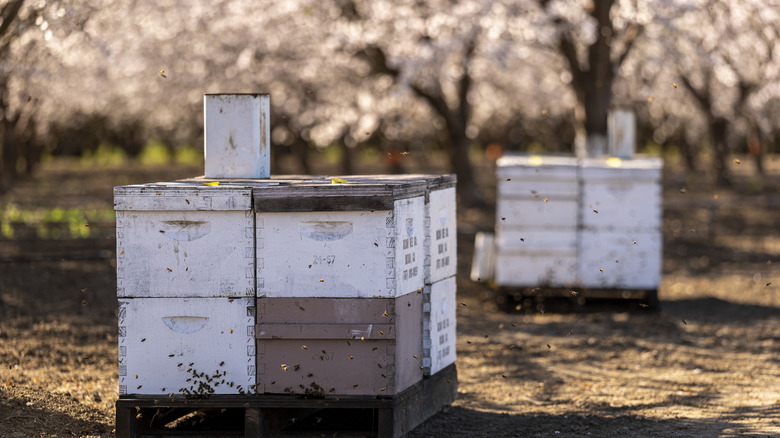How The Almond Industry Is Trying To Become More Sustainable
Almonds are enjoyed in many ways, from chocolate almond bark to a salad with green beans and red rice. It is also found in beverages like its own version of milk and as an ingredient in energy bars. Since the popularity of almonds has only grown in recent years, its industry has taken strides to be more sustainable during a time when it has faced significant natural challenges. Those challenges include a reliance on bees and water; both of which can be in short supply in California, where almonds are the state's largest crop (per SFGATE). The widespread death of honey bees, which are required for the pollination of almond trees, and drought across the state, have created significant hurdles for the almond industry.
Drought is nothing new to California. According to the National Integrated Drought Information System, California has been dealing with these conditions for decades. However, this factor is of great significance for the almond, which requires a gallon of water to produce just one nut, the New Republic reports.
When it comes to bees, almonds not only need bees for pollination, but the nutritious pollen of the almond trees helps honey bees. Of the 70% of the world's crops that rely on honey bees for pollination, almonds require more bees to be produced than any other crop, according to Select Harvest USA.
Sustainable practices
Feeling the strain of trying to meet the demand of the world's hunger for almonds while confronting water shortages and lack of bees buzzing through its orchards, the almond industry has adopted certain changes. The Almond Board of California's Almond Orchard 2025 Goals were created in 2018 in order to lead the industry in sustainable thinking and practices (via Food Dive).
The goals emphasize water efficiency, zero waste, pest management, and air quality, according to Food Dive. The Almond Board of California reports that the state's farmers are using research to improve their agricultural practices and reduce their impact on the environment. According to Almond Board of California, the industry has started to use less water for almond orchards, which stated that between the 1990s and 2010s, the industry used new policies to reduce the amount of water it uses for a pound of almonds by 33% and plans to reduce the amount further by another 20% by 2025.
Select Harvest USA reported that the almond industry is also trying to help bees deal with challenges from pests, pesticide and insecticides, climate change, and other impacting issues. To help take care of honey bees, the Almond Board of California created a guide called the Honey Bee Best Management Practices and is advising farmers to plant pollinator habitats near orchards to feed the bees before and after collecting almond pollen.
While the almond industry continues to face challenges, it is making strides with how it handles environmental pressures.

